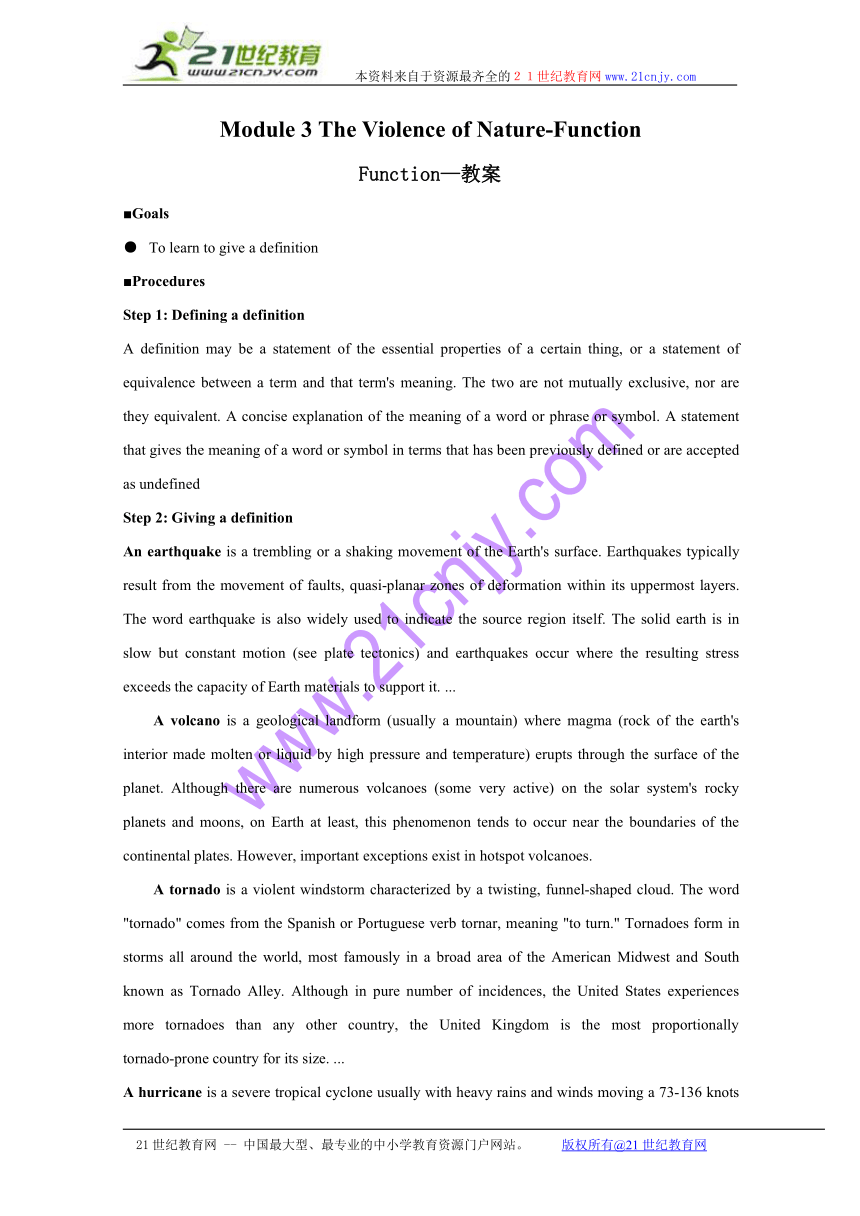Module 3 The Violence of Nature 教案-function(外研版必修3)
文档属性
| 名称 | Module 3 The Violence of Nature 教案-function(外研版必修3) |

|
|
| 格式 | rar | ||
| 文件大小 | 11.7KB | ||
| 资源类型 | 教案 | ||
| 版本资源 | 外研版 | ||
| 科目 | 英语 | ||
| 更新时间 | 2009-07-14 17:37:00 | ||
图片预览

文档简介
本资料来自于资源最齐全的21世纪教育网www.21cnjy.com
Module 3 The Violence of Nature-Function
Function—教案
■Goals
● To learn to give a definition
■Procedures
Step 1: Defining a definition
A definition may be a statement of the essential properties of a certain thing, or a statement of equivalence between a term and that term's meaning. The two are not mutually exclusive, nor are they equivalent. A concise explanation of the meaning of a word or phrase or symbol. A statement that gives the meaning of a word or symbol in terms that has been previously defined or are accepted as undefined
Step 2: Giving a definition
An earthquake is a trembling or a shaking movement of the Earth's surface. Earthquakes typically result from the movement of faults, quasi-planar zones of deformation within its uppermost layers. The word earthquake is also widely used to indicate the source region itself. The solid earth is in slow but constant motion (see plate tectonics) and earthquakes occur where the resulting stress exceeds the capacity of Earth materials to support it. ...
A volcano is a geological landform (usually a mountain) where magma (rock of the earth's interior made molten or liquid by high pressure and temperature) erupts through the surface of the planet. Although there are numerous volcanoes (some very active) on the solar system's rocky planets and moons, on Earth at least, this phenomenon tends to occur near the boundaries of the continental plates. However, important exceptions exist in hotspot volcanoes.
A tornado is a violent windstorm characterized by a twisting, funnel-shaped cloud. The word "tornado" comes from the Spanish or Portuguese verb tornar, meaning "to turn." Tornadoes form in storms all around the world, most famously in a broad area of the American Midwest and South known as Tornado Alley. Although in pure number of incidences, the United States experiences more tornadoes than any other country, the United Kingdom is the most proportionally tornado-prone country for its size. ...
A hurricane is a severe tropical cyclone usually with heavy rains and winds moving a 73-136 knots (12 on the Beaufort scale)
21世纪教育网 -- 中国最大型、最专业的中小学教育资源门户网站。 版权所有@21世纪教育网
Module 3 The Violence of Nature-Function
Function—教案
■Goals
● To learn to give a definition
■Procedures
Step 1: Defining a definition
A definition may be a statement of the essential properties of a certain thing, or a statement of equivalence between a term and that term's meaning. The two are not mutually exclusive, nor are they equivalent. A concise explanation of the meaning of a word or phrase or symbol. A statement that gives the meaning of a word or symbol in terms that has been previously defined or are accepted as undefined
Step 2: Giving a definition
An earthquake is a trembling or a shaking movement of the Earth's surface. Earthquakes typically result from the movement of faults, quasi-planar zones of deformation within its uppermost layers. The word earthquake is also widely used to indicate the source region itself. The solid earth is in slow but constant motion (see plate tectonics) and earthquakes occur where the resulting stress exceeds the capacity of Earth materials to support it. ...
A volcano is a geological landform (usually a mountain) where magma (rock of the earth's interior made molten or liquid by high pressure and temperature) erupts through the surface of the planet. Although there are numerous volcanoes (some very active) on the solar system's rocky planets and moons, on Earth at least, this phenomenon tends to occur near the boundaries of the continental plates. However, important exceptions exist in hotspot volcanoes.
A tornado is a violent windstorm characterized by a twisting, funnel-shaped cloud. The word "tornado" comes from the Spanish or Portuguese verb tornar, meaning "to turn." Tornadoes form in storms all around the world, most famously in a broad area of the American Midwest and South known as Tornado Alley. Although in pure number of incidences, the United States experiences more tornadoes than any other country, the United Kingdom is the most proportionally tornado-prone country for its size. ...
A hurricane is a severe tropical cyclone usually with heavy rains and winds moving a 73-136 knots (12 on the Beaufort scale)
21世纪教育网 -- 中国最大型、最专业的中小学教育资源门户网站。 版权所有@21世纪教育网
